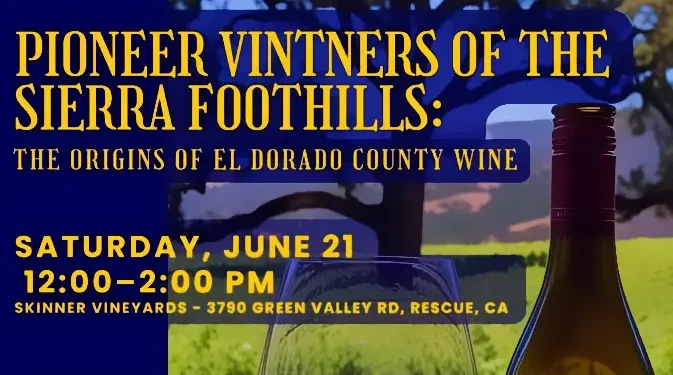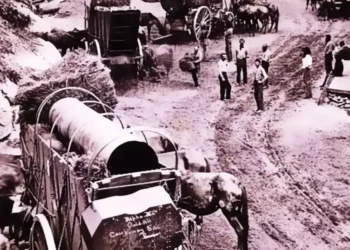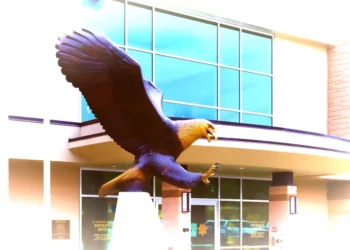By Cris Alarcon, InEDC Writer. (May 26, 2025)
EL DORADO COUNTY, Calif. — El Dorado County’s wine legacy is as rich and complex as the varietals it produces. Nestled in the Sierra Nevada foothills, this region’s viticultural journey began in 1848 with the discovery of gold at Sutter’s Mill, attracting a diverse influx of settlers, many of whom brought with them a tradition of winemaking.
El Dorado Wines
By 1870, El Dorado County had become one of California’s leading wine producers, trailing only Los Angeles and Sonoma counties. Approximately 2,000 acres of vineyards thrived, supplying wine to the burgeoning population of miners and settlers. However, the early 20th century brought challenges: economic downturns, a declining population, and the onset of Prohibition led to a significant decline in wine production.
El Dorado Wines
The region’s viticultural revival began in the late 1960s, when experimental vineyards demonstrated the area’s suitability for high-quality, dry table wines. This resurgence was solidified with the opening of Boeger Winery in 1973, the first post-Prohibition winery in the county. “We saw the potential in El Dorado’s unique terroir and climate,” said Greg Boeger, founder of Boeger Winery. “It was about honoring the past while looking to the future.”
In recognition of its distinctive wine-producing capabilities, the El Dorado American Viticultural Area (AVA) was established in 1983. Today, the county boasts over 50 wineries and more than 2,000 acres of vineyards, cultivating over 70 grape varietals, including Zinfandel, Barbera, and Rhône varieties. The region’s high elevations, ranging from 1,200 to 3,500 feet, combined with its diverse microclimates and soils, contribute to the production of wines with intense flavors and distinct character.
El Dorado County’s wine industry stands as a testament to resilience and innovation, blending historical roots with modern winemaking excellence.
-
Vineyard = the place grapes grow
-
Winery = the place wine is made
-
Vintner = the person making or selling the wine
The difference between a vineyard and a winery lies in what each does:
Vineyard
A vineyard is a farm where grapevines are grown. It’s all about the agriculture — planting, cultivating, and harvesting grapes. Not all vineyards make wine; some grow grapes to sell to wineries or produce table grapes instead.
-
Focus: Growing grapes
-
Key feature: Rows of grapevines
-
May or may not: Make wine on site
Winery
A winery is a facility where wine is made. It may or may not have its own vineyard — some wineries buy grapes from other growers. Wineries handle the winemaking process: crushing, fermenting, aging, blending, bottling, and storing wine.
-
Focus: Producing wine
-
Key feature: Winemaking equipment (fermentation tanks, barrels, bottling lines)
-
May or may not: Grow its own grapes
Example:
-
Boeger Winery in El Dorado County is a winery that also owns a vineyard.
-
A vineyard might just sell grapes to Boeger Winery without ever making wine itself.
In short:
Vineyards grow the grapes. Wineries make the wine.
Some places are both — but not always.
Two Common Meanings of “Vintner”:
-
Winemaker
In the U.S. and modern usage, a vintner often refers to a winemaker — someone who is directly involved in the science and art of turning grapes into wine. This includes decisions about fermentation, aging, blending, and bottling. -
Wine Merchant
Historically (and still in parts of Europe and in traditional British English), a vintner can also mean a wine seller or dealer — someone who buys and resells wine rather than making it.
In El Dorado County
In regions like El Dorado County, where many wineries are small and family-run, the vintner may wear many hats:
-
They grow grapes (like a vineyard manager),
-
Make the wine (like an enologist),
-
And sell it directly (like a merchant or tasting room host).
UPCOMING EVENT
Pioneer Vintners of the Sierra Foothills – The Origins of El Dorado County Wine!
12:00 – 2:00 PM
Skinner Vineyards – 3790 Green Valley Rd, Rescue, CA
– Engaging historical presentation with local historians and descendants of pioneer winemakers.
– Curated wine tastings from Skinner Vineyards.
– Delicious gourmet charcuterie pairings.
– Exclusive shuttle tour to rarely-accessible historic winery sites, including:
* The original Skinner family wine cellar and vineyard.
* The historic Zentgraf winery and rammed-earth home (now on the National Register of Historic Places!).
* The Zentgraf Pioneer Cemetery with insightful interpretation by Mike Roberts of Save the Graves El Dorado.
$125 General Admission
$100 for El Dorado County Historical Society (EDCHS) Members (Members, check your email from programming@edchs.org for your special member discount link!)
We look forward to celebrating El Dorado County’s storied wine heritage together!










